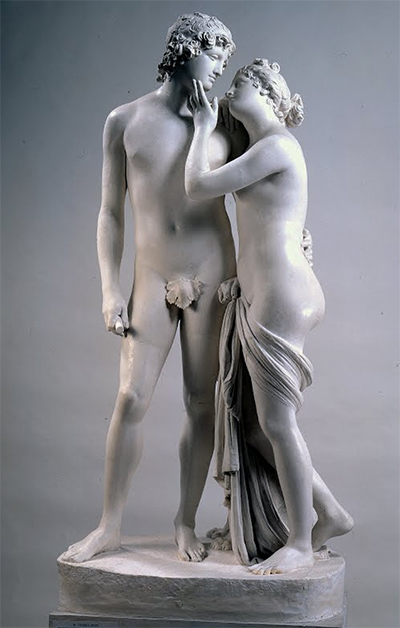Venus and Adonis is a sculpture by Antonio Canova in 1794. It is made from plaster, and depicts a man and a woman, probably from the medieval period.
The sculpture shows Venus bidding farewell to Adonis as he goes out to hunt. It has a basis in history as it was the last time Venus would see Adonis alive. He died during the hunting trip. The woman is leaning on the man’s shoulder with her left hand on the man's cheek, an expression of love. The eyes lock to show mutual feeling. Adonis left hand is around her waist while the right-hand holds a hunting stick. Both of them are naked, save for a leaf and piece of cloth covering Adonis and Venus's private parts, respectively.
The original sculptor is at The Musées d'Art et d'Histoire in Geneva and measured 180 cm high and 80 cm wide. Another version of Venus and Adonis is at Buckingham Place in the United Kingdom. Similar pieces of art by Canova include Damoxenos (1796), Orpheus (1777), Thesus and the Minotaur, George Washington, Psyche Revived by Cupid Kiss (1787) and The Three Graces (1814 to 1817).
Antonio Canova and Neo-classical Style
Born to a stonecutter and raised by a stonemason grandfather, the young Canova developed an interest in sculptor at a young age. He did his pupillage in Venice, coached first by Giuseppe Bernadi and later by Giovanni Ferrari. He enrolled at the Arts Academy in Venice, where he won numerous prizes, thanks to his talents. His first assignments included producing Orpheus (1777) and Eurydice for Senator Giovanni Falier.
His inspiration was a mixture of Baroque style and the classical revival. He was also good with painting, evident from his self-portrait in 1792. This combination earned him respect as one of the greatest neoclassical artists in the 18th and 19th centuries. Some of his works were at the Feast of Ascension in 1777, where he won admiration from fellow exhibitors and artists. His fame travelled with him to Rome, France, and England.
Along the way, he mentored John Gibson, Aristide Fontana, and Richard Westmacott. His efforts landed him in influential administrative positions such as the President of the Academia di San Luca, Art Patron in Europe, and the Associate member Netherlands Royal Art Institute.




